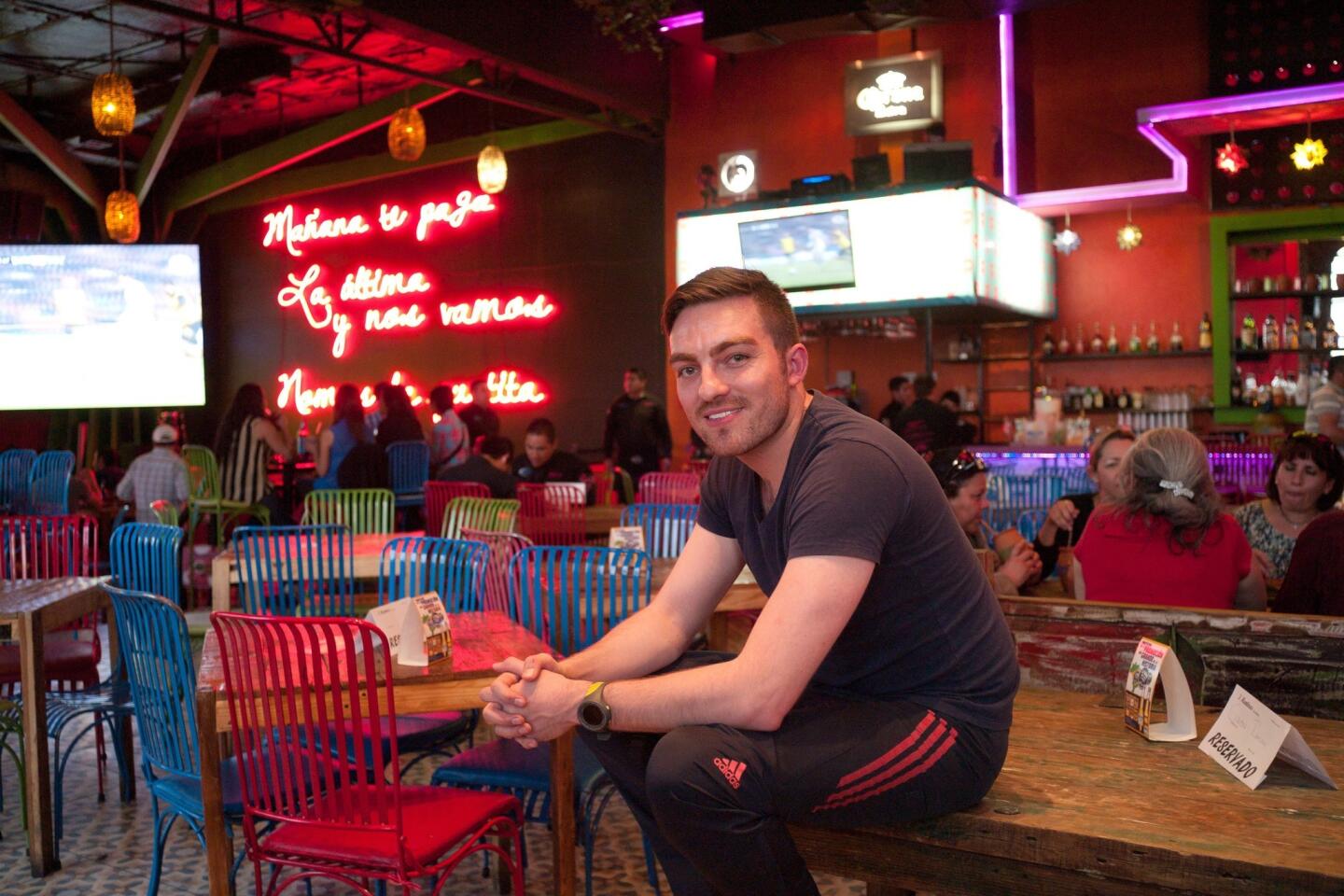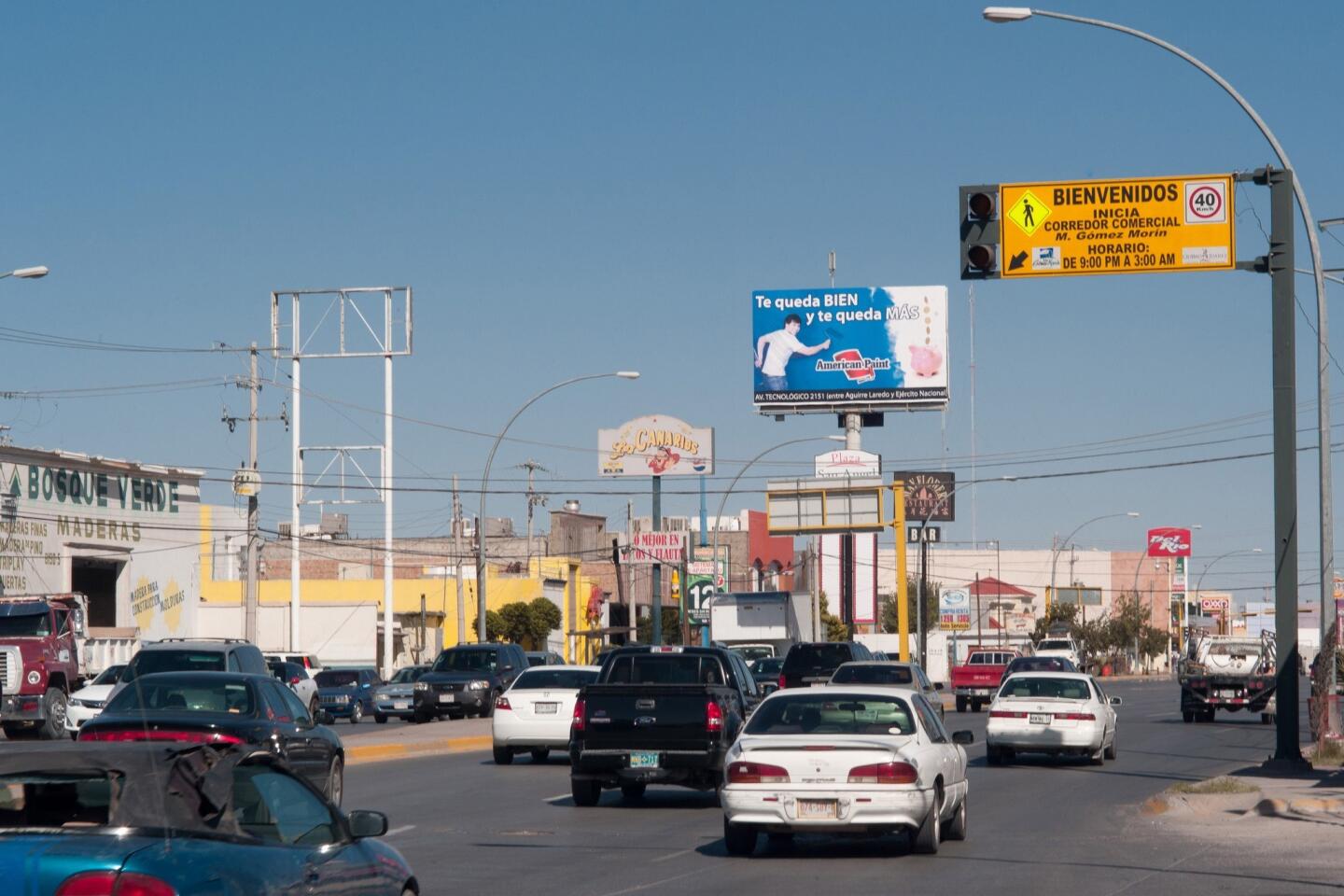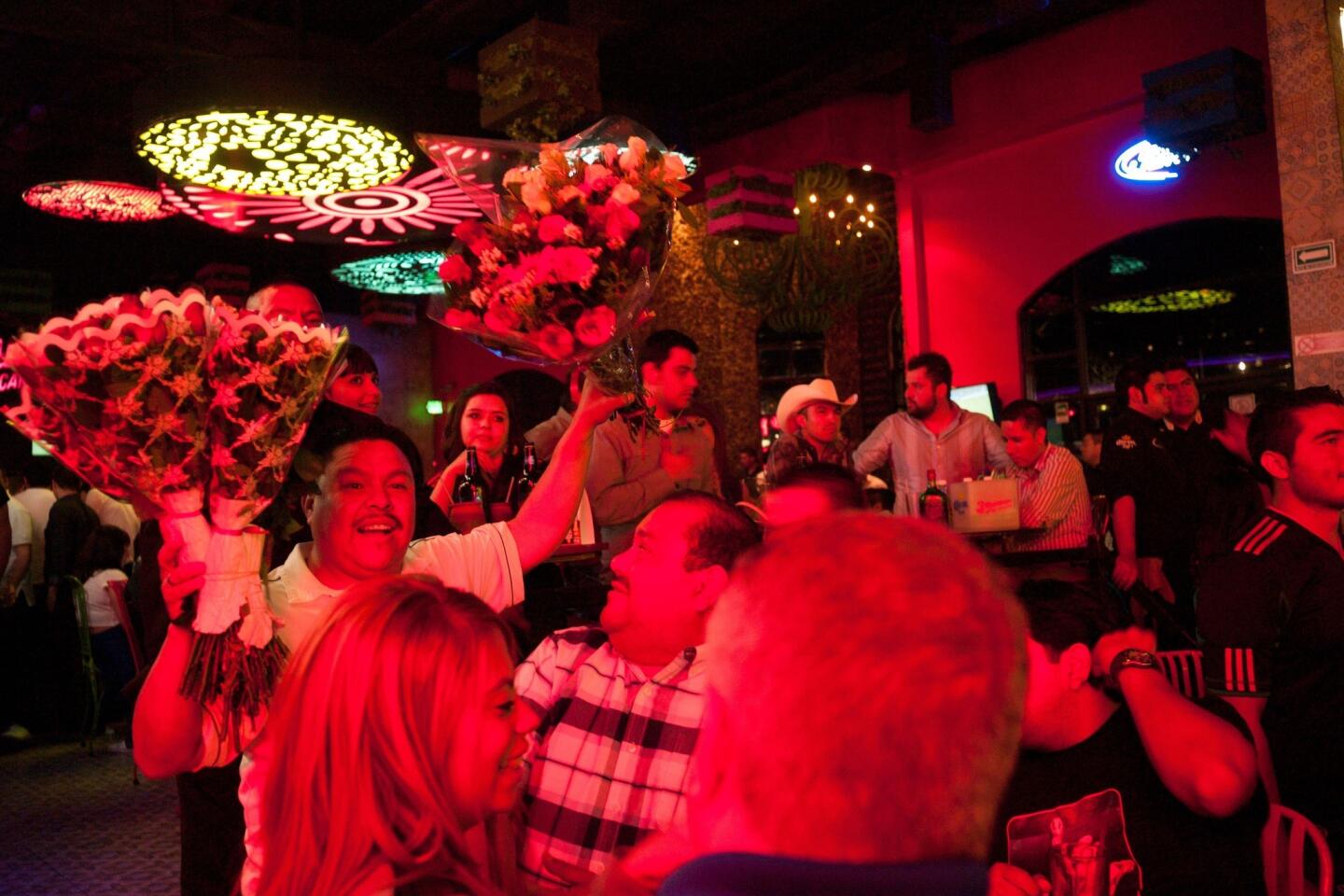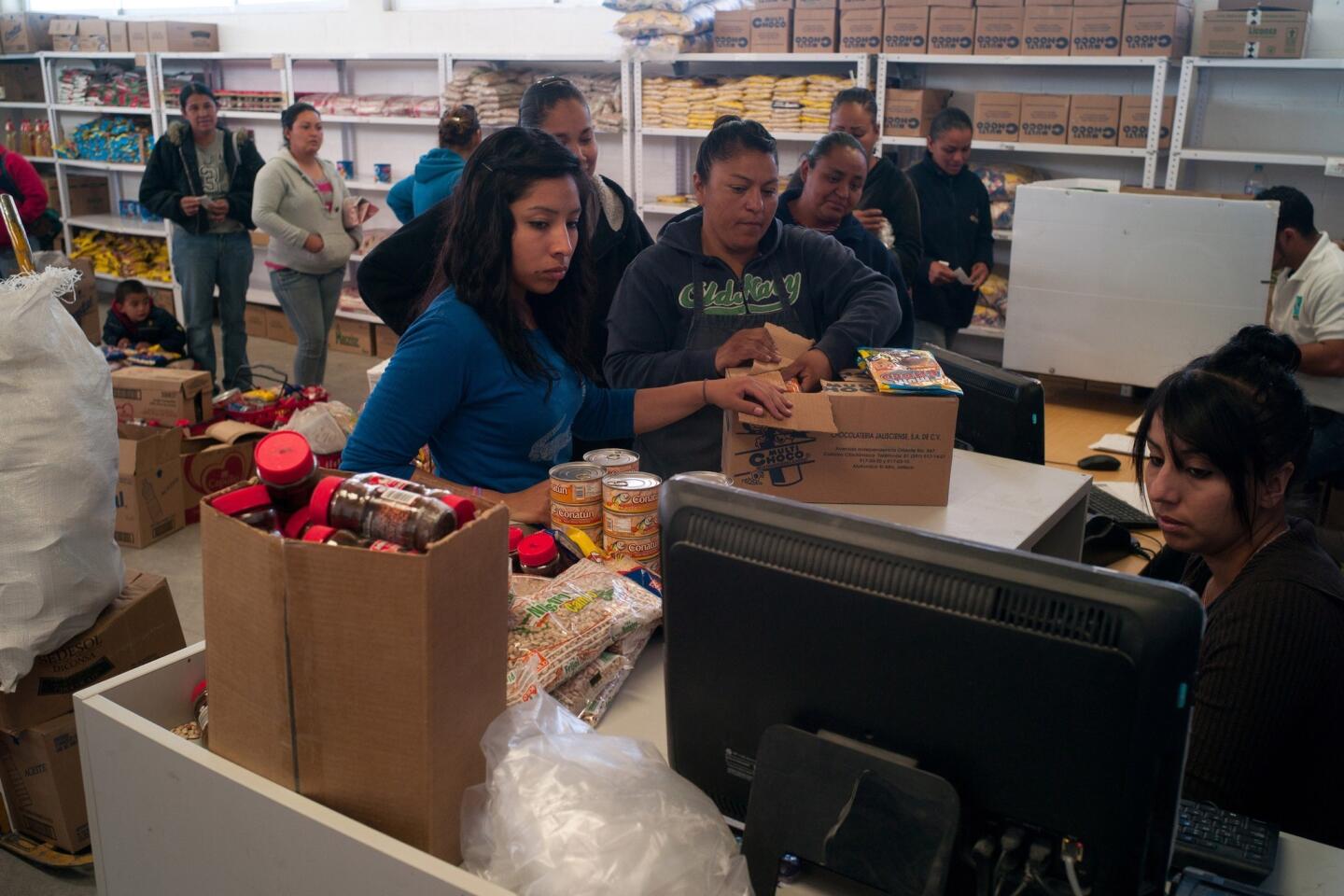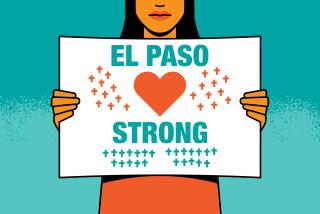In Mexico, Ciudad Juarez reemerging from grip of violence
- Share via
Reporting from Ciudad Juarez, Mexico — Angel Corral is in many ways the new face of a city long known for its criminal gangsters and one of the world’s highest homicide rates.
At 29, with pale green eyes and a can-do spirit, Corral is riding Ciudad Juarez’s return to life, running three nightclubs and investing in a gym. Where all his money comes from is not exactly clear, but no one seems to be asking questions.
The reasons for the border town’s revival are also unclear, and the uplift could well prove short-lived. But there is no question that homicides have declined precipitously and that shuttered businesses are reopening.
As the city climbs out of the depths of despair, Corral and a host of other residents — including returning exiles — are jumping aboard.
Five months ago, Corral opened his most successful bar, the Tres Mentiras (Three Lies), with a blue-tiled dome and pink neon signs. The metal detectors at the door and the posse of bodyguards dressed in black and wearing earpieces speak to a more violent time. Yet the cavernous place is routinely packed, with lines outside, for performances by Los Tigres del Norte or on ladies’ night, when drinks go for a dollar.
Just a couple of years ago, Gomez Morin Boulevard, at the commercial heart of Juarez, had become a ghost town, like much of the city just across the Rio Grande from El Paso. Drug, extortion and kidnapping gangs ran amok, fighting turf wars and terrorizing rich and poor. Today, much of the city, including the boulevard where the bar is located, is bustling, replete with signs saying “Now open” outside restaurants, casinos, spas and yoga studios.
“The city is reestablishing itself,” Corral said. “The economy still lags behind. We haven’t returned to [the prosperity of] 2008, but maybe in a couple of years we will be back to that level. So we want to be in position for that.”
The energetic businessman thinks rival gangs — largely responsible for the rampage that peaked at 60 killings a week in 2010 in a community with roughly the population of San Diego — probably made deals to coexist once the federal police were withdrawn 2011.
Others think a more powerful trafficking network, such as Joaquin “El Chapo” Guzman’s Sinaloa cartel, might have moved in and restored a kind of order among thieves in a city once claimed by the Juarez cartel and many smaller gangs.
“Being able to do business is in everyone’s interest,” Corral said. “I don’t think Ciudad Juarez will revert to the worst times.”
As bad as it got, Corral never moved away, confident the city would eventually snap back.
Oscar Herrera, a prominent chef, fled to El Paso the day after one of his family’s eateries was burned down by vengeful racketeers in 2008. His own restaurant on Gomez Morin was failing because diners were afraid to venture out at night.
Now, he too is taking a chance that the worst is over. He returned with his wife and children about two years ago, though he might have the kids commute to school in Texas as they get older.
He’s expanding his business, opening a large, modern wholesale bakery offering ciabatta, croissants and sourdough bread. It is a bakery unlike many others, however: It has bulletproof windows, electrified fencing and coded key padlocks at the doors.
“Before they would shoot you as if it were nothing,” said Herrera, 40, as he shaped rose-pink rolls, flavored with beet juice. “Fear is like the flu: It’s contagious. But so is hope.”
Nearby, on the phone, Yesenia Chavira, 26, was taking orders from pastry shops eager to buy Herrera’s breads.
“It’s much better now, but you always have to be alert,” she said, recalling a recent half-hour shootout across town. “That makes you think it could be starting up again.”
Like Corral, Chavira, her blond hair held back by a rhinestone headband, endured through the bloodiest times. “I always felt that if you want a city to get better, you have to cast your lot with it. There is no other way,” she said.
Nearly 11,000 people were killed in Ciudad Juarez from 2007 through 2013.
Homicide statistics are not completely reliable, and the government has been accused of manipulating the numbers to show a decline. Yet there is little doubt that the number has dropped since 2012. Officially, 114 people were killed in the city in the first three months of 2014, an average of about 10 a week.
There continue to be spurts of mass bloodshed: 10 people, including children, shot to death as they celebrated a baseball victory in September; eight members of one family, including three children, stabbed to death on Nov. 16.
Streets are still sprinkled with roadside shrines, black crosses painted on lampposts, and a makeshift memorial for the several hundred women among those killed. But there is also new graffiti with slogans such as, “Changing depends on you. A city can be something else.”
Motorists finally feel safe enough to roll down their car windows.
Building on a batch of programs launched by the previous administration, the government of President Enrique Peña Nieto has targeted some of Juarez’s most depressed, virtually abandoned neighborhoods.
Slowly, families have returned to places like Riberas del Bravo, a desolate sandy expanse with row upon row of tiny, uniform stucco houses that seem to have sprouted up like tumbleweeds. The wall separating Mexico from Texas is on the horizon.
Violence was so severe in the area, and poverty so deep as the economy plummeted, that the residents of entire blocks moved out, often to other cities. Most of the graffiti-marked houses have been vandalized, windows and doors chiseled away. Trash fills streets overgrown with weeds. But every few yards, life has returned, evident by laundry hanging on clotheslines or a family dog pacing on a roof.
At a government-run community center, a two-story building painted bright white and green and looking like a mirage glowing in the desert, women line up for heavily subsidized food, which is sometimes free. Some wait five hours or more, leaving their homes at 4 a.m. to collect packages of rice, beans, cooking oil and instant coffee.
“Violence went down a little, but go out at night? No way!” said Valeria Lopez, 23, a mother of three whose husband earns the equivalent of $58 a week at a maquiladora plant making packing material for TV sets being exported to the U.S.
At the community center, social workers and counselors seek to overcome what they describe as a cycle of brutality that was destroying family life. Men raped women, women beat their children, and some children went so far as to commit suicide, the counselors said.
The workers together counsel 350 people a week, mostly women, and have taught them how to protect themselves. Many have formed neighborhood watch patrols and carry whistles to warn of potential burglars or drug dealers.
“We are on the way to a sense of peace, but we have a long way to go,” said one of the counselors, Veronica Arango. “We are just one piece in a big jigsaw puzzle.”
Jorge Contreras Fornelli, a sofa manufacturer and past president of a citizens’ panel that studies security issues, said the violence was fed by the 2008 global economic crisis and the fact that criminals were rarely caught or prosecuted. The resulting exodus of firms caused 30% of the workforce to lose their jobs, he said.
Contreras sent his wife and children to El Paso when kidnappings reached his circle of friends and relatives. A cousin and a neighbor were kidnapped and killed, even though their families had paid ransoms.
Juarez has a chance to heal, he said, if citizens and business leaders remain engaged and if nascent reforms of the police and judiciary take hold.
“It is difficult for me to say whether [the relative calm] is permanent,” Contreras said. “For fundamental change, we will have to work, work, work.”
More to Read
Sign up for Essential California
The most important California stories and recommendations in your inbox every morning.
You may occasionally receive promotional content from the Los Angeles Times.
